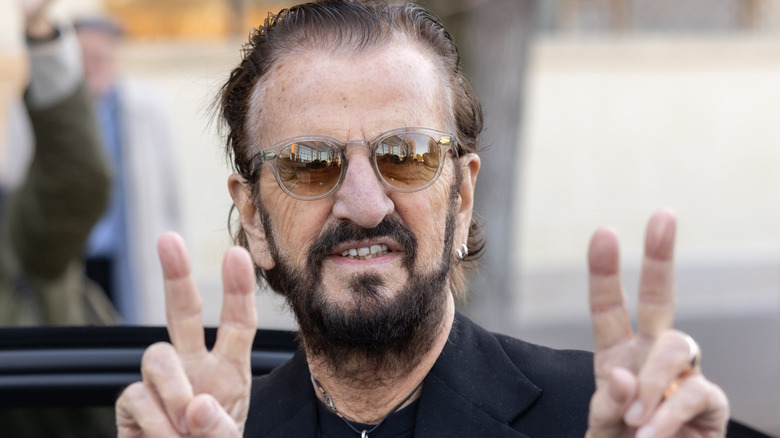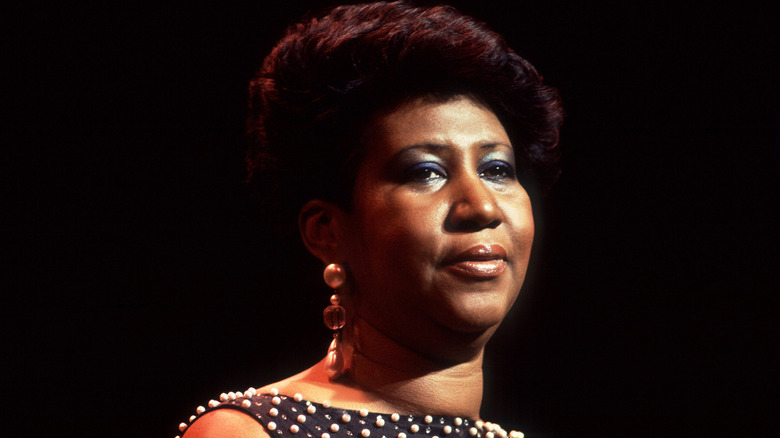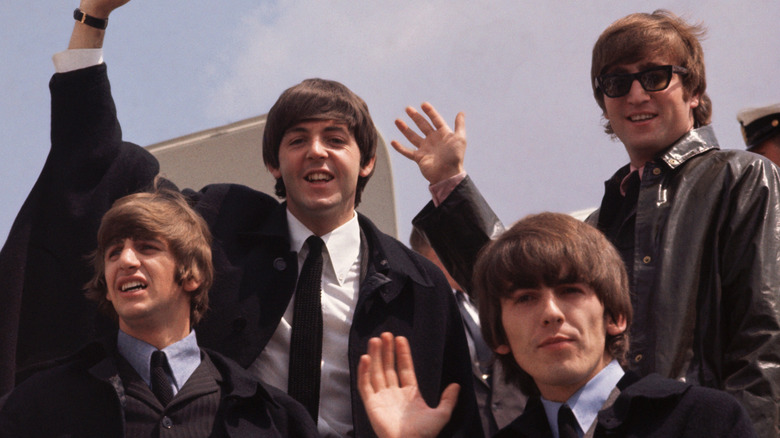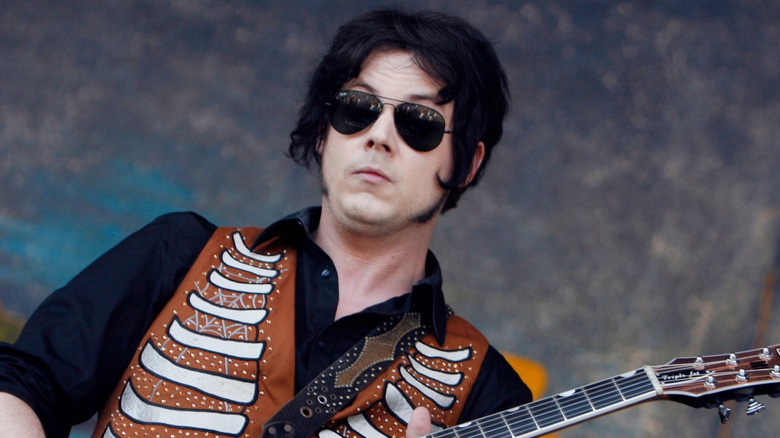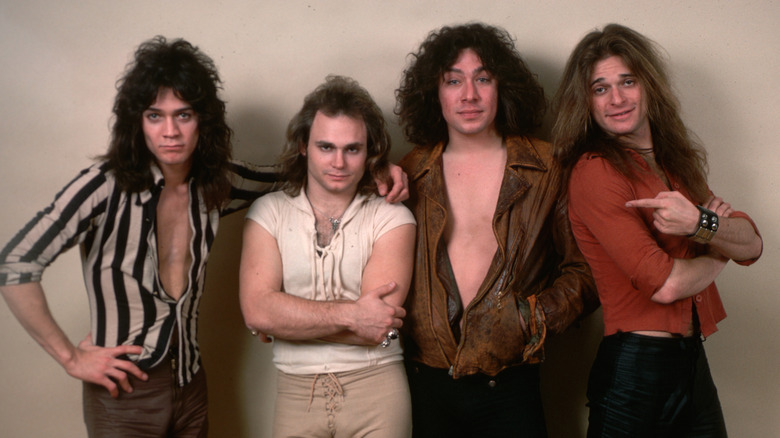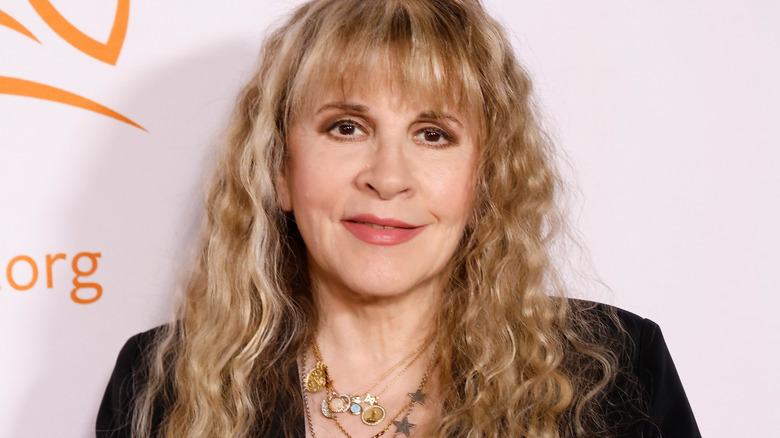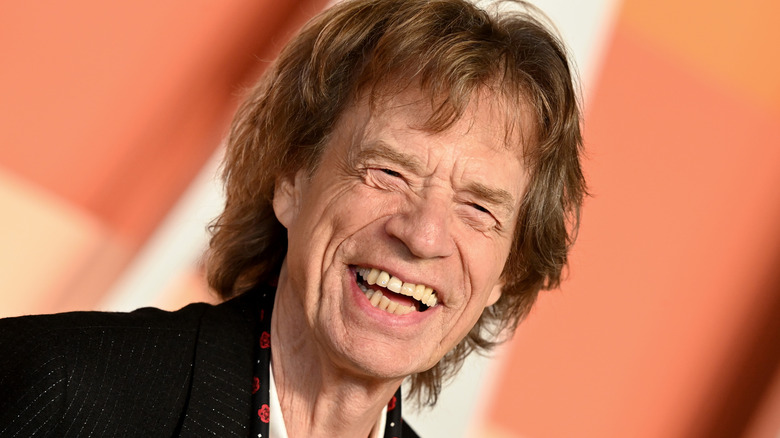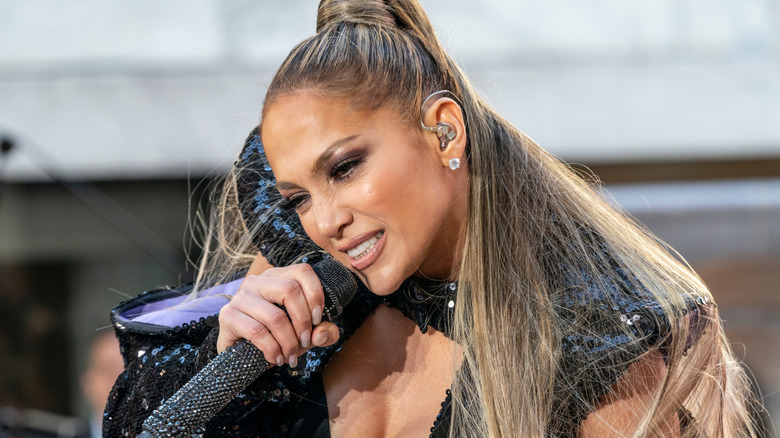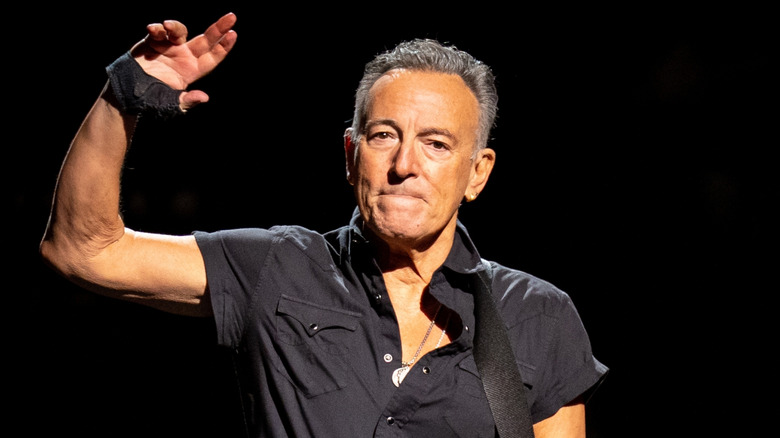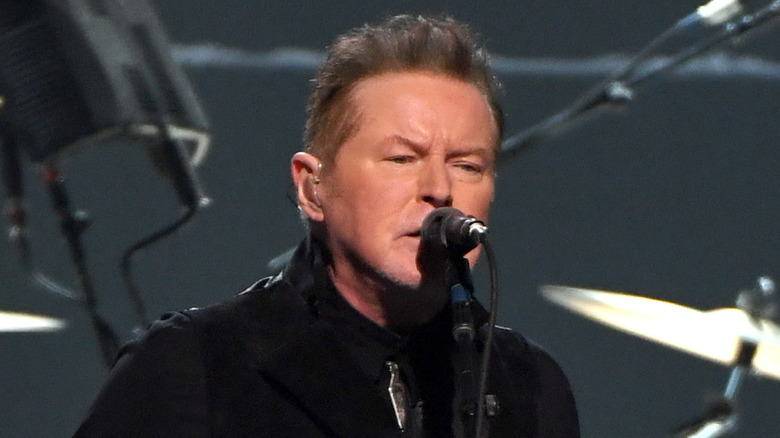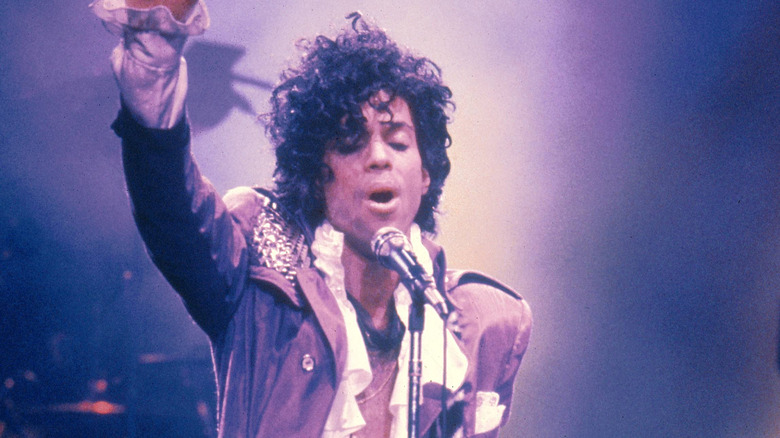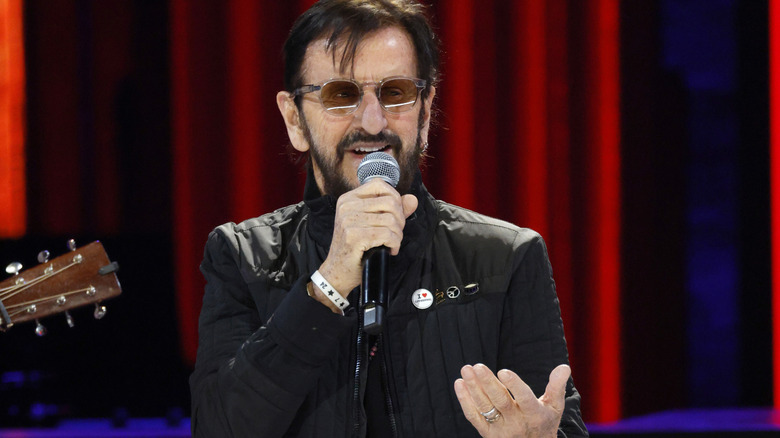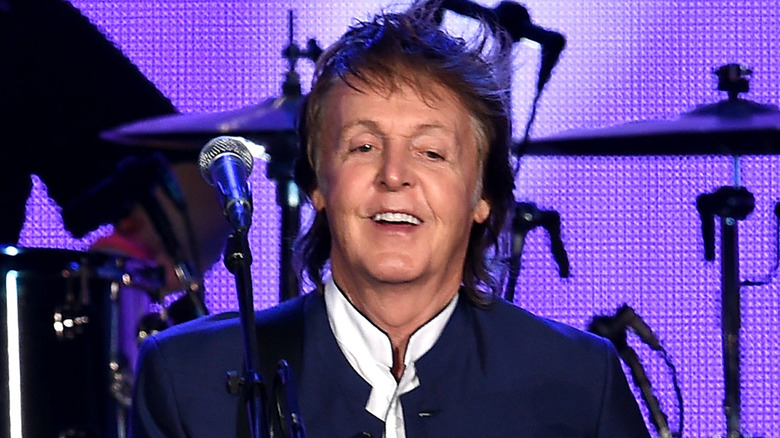Strict Rules Famous Musicians Made People Follow While On Tour
Of the many false facts about classic rock artists we've all collectively believed, the biggest lie is probably the notion that rock musicians are a laid-back bunch. It's a romantic idea that singers, guitarists, and drummers all pile into a van or tour bus and hit the road to sing their fist-pumping anthems of youth and rebellion to screaming fans, driven by a love of the art and the gritty lifestyle. It's simply not true: The lure of fame and fortune is strong in the worlds of pop and rock, and stars can earn an obscene amount of money performing their songs to appreciative crowds every night.
Some musicians and bands can be absolute nightmares on tour, either because of a seeming need to party excessively or because they put their employees, road crews, and venue staff through the ringer to ensure that the show goes on, and that they're placated and happy enough to play. Because those rock stars have grown rich, they're accustomed to a certain lifestyle, which includes getting whatever they want, whenever they want it, and from everybody. Here are some famous musicians with airtight lists of on-tour rules that everyone around them must observe.
Aretha Franklin
When people came to hear Aretha Franklin sing, they expected a tremendous vocal performance from a true legend and master. To keep her voice healthy enough to belt out R&B, soul, and gospel-influenced classics night after night, Franklin took certain measures that often impacted the comfort of her staff and even the fans who paid a lot of money to see the Queen of Soul perform. Franklin's performance contract banned air conditioning — everywhere. "All air conditioning vents must be turned off or taped shut, to prevent any cold air from flowing into Aretha Franklin's dressing room," the document read (via The Smoking Gun). "In addition, all vents from Ms. Franklin's dressing room, backstage area and stage and in the venue, must be turned off at least one hour prior to Ms. Franklin's scheduled rehearsal and performance times."
And whatever small fortune Franklin stood to gain from what could have been a very warm and uncomfortable evening, the singer was contractually entitled to a down payment. Sometime during the day of the performance, Franklin, and Franklin alone, was to be given a $25,000 payment in cash from the promoter.
The Beatles
In the mid-1960s, the Beatles were the biggest rock band in the world and the most dominant thing in all of pop culture, too. Beatlemania had struck far and wide, and the Fab Four had the kind of clout to make demands that superseded or negated common practices in the cities where the band performed. According to a contract that beheld the band to play two shows on August 31, 1965, at the Cow Palace, a concert venue outside of San Francisco, the Beatles wouldn't go on stage without someone installing a special, extra-large platform for drummer Ringo Starr and giving the musicians their fee of $40,000.
And although the Civil Rights Movement had been going on for several years by the time the Beatles broke through in the U.S., many public places operated under segregation, separating white patrons from people of color. The Beatles wouldn't play a spot unless it was integrated, and it was written into the contract, as was a request to hire 150 police officers, in uniform, to protect the musicians from their besotted fans.
Jack White
A tour rider is a list of necessities and requests put together by a musician and their management team and issued to concert promoters and organizers. Riders deal primarily with the technical aspects of a show, but they also include the foods, beverages, and comfort items the performer wants to see in their dressing room. Rocker Jack White simply can't perform without access to chips and guacamole. It's a very important snack to White, but not just any store-bought, restaurant-prepared, or even freshly made guacamole will suffice. His rider includes not only a request for guacamole, but detailed instructions for how to make the exact guacamole that White wants to eat.
Per White's directive, a member of the backstage crew needs to carefully slice and cube eight large Haas avocados and combine the flesh with four diced vine-ripened tomatoes, half of a chopped yellow onion, an entire bunch of cilantro, four deveined and chopped Serrano peppers, lime, salt, and pepper. White also wants the pits from the avocados saved and placed inside the guacamole, which ideally shouldn't be served any later than 5 p.m. on show nights.
Van Halen
The 1982 Van Halen World Tour was one of the largest live touring productions ever attempted, with extensive lighting, special effects, and staging rigs that needed to be carefully set up and then taken down at dozens of arenas and coliseums, primarily around the United States. The instructions provided by the band's management to each city's venue and production staff filled more than 40 pages and patiently described how everything ought to look and function to ensure the safety of the band, audience, and crew.
The members of Van Halen needed to be able to trust their load-in crews, and so they buried in their rider a small test that would enable them to know with one quick glance if everything was safe and functional. On page 40 of the document, under "Food Requirements (Band)," one line item requests "M&M's (Warning: Absolutely no brown ones)." If lead singer David Lee Roth walked into the backstage area and "saw brown M&M's on the catering table, that guaranteed the promoter had not read the contract rider, and we had to do a serious line check," he said in a 2012 video.
Stevie Nicks
Fleetwood Mac was one of the most popular bands in America in the late 1970s. After the blues band rebooted itself into a soft rock act with the addition of guitarist Lindsey Buckingham and singer-songwriter Stevie Nicks, 1977's drama-fueled "Rumours" LP sold more than 21 million copies. When the band toured behind the follow-up "Tusk" in 1979, Nicks was a superstar, and she could get away with truly audacious behavior and demands. In the lead-up to Fleetwood Mac's arrival in town, promoters had to find Nicks a luxurious hotel room and then make sure it was painted almost entirely pink. One of only a few things that didn't need to be that color was a piano — Nicks demanded an all-white instrument be placed in her room, should she be in the mood to compose a song during her stay.
Still, even if organizers and employees followed Nicks' instructions perfectly, a poor vibe could lead the singer to suddenly bounce. "One of Stevie's almost comedic needs ... is what we call hotel-hopping, where we all check into a hotel and she goes, 'Oh, I need to try another one,' and just checks out," bandmate Mick Fleetwood told Vulture.
Mick Jagger
Mick Jagger has been actively touring and recording as the frontman of the Rolling Stones for more than 60 years. Not only is he one of the most famous faces in rock history, he's also among the very richest, with a net worth in the area of $600 million. At this point, Jagger is both so road-weary and demanding of the finer things in life that he can greatly ease the travel-related drudgery of a Rolling Stones tour.
Wherever and whenever his band plays a concert, Jagger gets to stay in a room at one of the nicest and most expensive hotels in the area. He also gets to enjoy a brand-new bed. Before he arrives for his brief stay, the establishment must bring in a new, never-used mattress and leave it encased in the thin plastic wrapper in which it's shipped. Then, before Jagger deems it suitable for his use, an employee spends a night sleeping on it — on top of the plastic — in order to soften it just a little.
Jennifer Lopez
Pop star and actor Jennifer Lopez has a reputation as something of a diva, and her tour riders fully back up that assessment. Even when she was just being considered as the musical guest during the opening of a Premier League cricket tournament in India in 2013, her manager Benny Medina sent over some requirements: Lopez would need to arrive at the event via a private aircraft and needed multiple hotel rooms for her stylists and other members of her entourage. Lopez ultimately didn't get the job after organizers got a look at the hefty rider.
On other Lopez tours, promoters made good on the singer's backstage and dressing room dictums. Staff had to deck out Lopez's private rooms all in white, which included bringing in white couches, leaving out white candles to burn, and serving only white food, such as fish. One of the few non-white things at Lopez's disposal is coffee, which must only be stirred counter-clockwise, or else the singer reportedly won't touch it.
Bruce Springsteen
Listening to Buddy Holly before his shows is just one of many rituals for Bruce Springsteen. The populist, everyman rock star known as "The Boss" isn't exactly the no-fuss, low-maintenance, regular guy his music and public persona would suggest that he is, because he tours with a 37-page list containing more than 100 hyper-specific requests that he needs his large crew to fulfill.
Someone, or someones, must ensure that a broth-heavy cauldron of chicken soup is ready to go before the concert, and that exactly 16 cold, large shrimp are available to eat afterward, along with two small bags of Rold Gold pretzels. The shrimp require a homemade sauce; no other brands are allowed in place of the Rold Gold. Other backstage food and food-related Springsteen needs include a 16-ounce bottle of hand-squeezed lemon juice and six hard-boiled egg whites. Springsteen's wife and backing musician Patti Scialfa wants to see three fashion magazines in her own dressing room, along with a vase of all-white roses, and guitarist Steven Van Zandt will dine only on seafood that's been wild-caught.
Promoters must add to their workforce on Springsteen concert days. The musician and his band need access to a massage therapist who is trained in both sports and deep tissue styles, as well as a manicurist who can work on men's nails and women's nails, particularly acrylic treatments.
Don Henley
Despite recording some of the smoothest and most peaceful, easy-feeling music of all time, the story of the Eagles is a tragic one, filled with lots of fighting and animosity. Drummer and co-lead singer Don Henley bore the brunt of a lot of that personal and professional tension, and it may have inspired the modus operandi for how business is conducted backstage at concerts throughout his successful solo career.
Henley is seemingly deeply concerned about making sure he gets to see his mail as soon as possible, particularly if there's anything potentially dangerous or hostile in it. "Promoter shall provide timely delivery of all messages, letters, gifts, etc. to the Artist, Artist's Representatives and Tour Accountant," his concert agreement reads, according to the San Diego Reader, "with particular urgency provided for the delivery of messages or other items of a bizarre, threatening or otherwise inappropriate nature." Henley's handlers have to be careful about greeting delivery people and intercepting any notes or gifts when they arrive, however, because the musician really doesn't want to interact with anyone who isn't a co-worker. "The presence of anyone backstage who is not involved in the performance (including friends, guests, relatives, and business acquaintances of the promoter) will cause artist to become extremely upset."
Prince
Staff, crew, and helpers obviously had to be in the presence of the storied and legendary Prince to work for him, but the musician helped manage what was obviously an uncomfortable situation for him with a great number of stipulations that governed personal interactions with employees. "A lot of people, before I started working for him, gave me a lot of rules, 'Don't touch his ears. Don't do this. Don't look at him in the face,'" Prince's hairstylist of two decades, Kim Berry, told "20/20." Prince later told Berry that all of those rules were just rumor and myth, despite other accounts to the contrary. "He had a rule, and that was we were always to call him boss, and never to look into his eyes directly," graphic designer Lizz Frey told The Mirror. When fellow rock star Sammy Hagar asked Prince's guitar tech, Zeke Clark, for a backstage introduction in 1985, Clark couldn't help him because his wasn't permitted to talk to the boss.
When Prince performed at the Hop Farm Festival in the U.K. in June 2011, his tour rider called for a dressing room that was painted his favorite color, purple, and populated with purple furniture and decorations. Previous tours compelled organizers to supply Prince with an oxygen bar and a device that dispensed only black M&Ms, and consumables and objects in the artist's quarters had to be covered in plastic wrap that only Prince could remove upon arrival.
Ringo Starr
Thanks in large part to his eight-year stint in the Beatles that ended more than 50 years ago, drummer and singer Ringo Starr lives an unbelievably lavish life. In recent years, he's become a major live concert draw as a solo performer and as the leader and curator of the ever-changing supergroup Ringo Starr and His All Starr Band. When he's not on the road, Starr lives in luxury at one of his many well-appointed homes around the world. But when he's in the middle of a tour, he's all business, to the point where his bandmates can expect to work hard, or at least as hard as Starr himself.
"I was in Atlanta in bed with the flu once and had to cancel two gigs, that's the only time," Starr told Pollstar in 2023 of his no-show history. (He also cancelled two shows in 2024 because of illness.) "I keep telling the band, if only three people turn up, we're playing." It's an unofficial but closely followed rule that if Starr is on tour, he'll play as many gigs as possible, as many as 22 shows per month for multiple months out of the year. "The key for us is good routing and comfortable travel," tour manager Dave Hart said. "He would rather be playing than sitting in a hotel and he's told me that on numerous occasions." In 2023, Starr noticed a two-day break in the schedule and asked Hart to fill in the gap with a couple of concerts.
Paul McCartney
Probably one of the world's most famous anti-meat-eaters, Paul McCartney adopted a vegetarian lifestyle in 1975, shortly after watching lambs frolic on his farm while eating lamb chops and feeling sick about the whole thing. Both McCartney and his first wife, Linda McCartney, strongly advocated for vegetarianism, including the 1991 launch of the meat-free frozen line Linda McCartney Foods and the couple's appearance on a 1995 episode of "The Simpsons" in which they help Lisa Simpson embrace the vegetarian way — but only after the show's creators agreed that Lisa would remain a vegetarian permanently.
Avoiding meat and animal products is a choice, but it's one that Paul McCartney has been rather forceful about. His concert tour productions provide meals for the entire crew at each stop, and those are prepared by a staff that only makes vegetarian food. If anyone wants to eat meat, they can do so on their own dime and away from their co-workers. Maintaining a completely meat-free backstage environment is a rule that's been in place at McCartney concerts since 2004.
